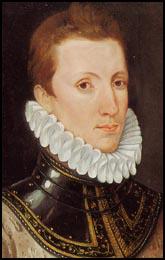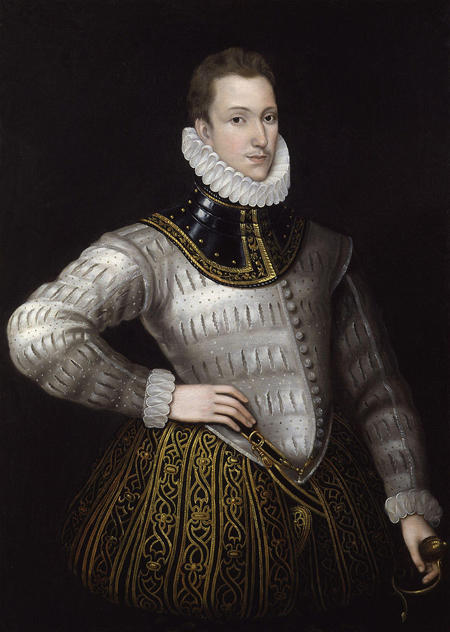Philip Sidney

Philip Sidney, the eldest son of Sir Henry Sidney, Lord Deputy of Ireland, was born in Penshurst Place on 30th November 1554. His mother, Mary Sidney, was the daughter of John Dudley, Duke of Northumberland. Her brother was Robert Dudley, Earl of Leicester.
Sidney attended Shrewsbury School. The headmaster was Thomas Ashton, a former fellow of St John's College, and under his direction Sidney studied Latin and Greek.
On 2nd February 1567 Sidney was enrolled as a member of Gray's Inn, and a year later, aged thirteen, he began his career as an undergraduate at Christ Church. Other students being educated at Oxford University at the time included William Camden and Walter Raleigh. (1)
It was while at university he began writing poetry. However, he made no attempt to get his work published: Sidney commented that at this time "our nation hath set their heart's delight upon action and not upon imagination, rather doing things worthy to be written than writing things fit to be done". (2)
Sidney became engaged to Anne Cecil, the daughter of William Cecil, on 6th August 1569. However, the contract seems to have broken down, for in the summer of 1571 Anne was betrothed to Edward de Vere, 17th Earl of Oxford. He spent the next year travelling in Europe. In Paris he lodged with the English ambassador Sir Francis Walsingham. On his return in 1572 he was elected to represent the people of Shrewsbury in the House of Commons. (3)
Philip Sidney - Poet
Sidney fell in love with Penelope Devereux. It is believed that this love affair inspired the writing of Astrophel and Stella, a work that contains 108 sonnets and 11 songs. (4) As Christopher Morris, the author of The Tudors (1955), points out: "The love which the poets apostrophised might almost be called a communal emotion. It was considered as a passion felt by all men in much the same way: and, until Sidney wrote Atrophel and Stella, it was rare for a poet to analyse what made his passion different from another." (5)
| Spartacus E-Books (Price £0.99 / $1.50) | ||||||
|---|---|---|---|---|---|---|
Philip Sidney also wrote An Apology for Poetry. He defended poetry partly on account of its political utility: "Is the poor pipe disdained, which... can show the misery of people, under hard lords, and ravening soldiers? And again... what blessedness is derived, to them that lie lowest, from the goodness of them that sit highest." In Sidney's Arcadia, a prose pastoral romance designed to "represent the growth, state, and declination of Princes... with all other errors, or alterations in public affairs" was interspersed with poems. (6)
It has been argued by Robert Lacey that "Sir Philip Sidney had seemed to represent an Elizabethan ideal: the literate, gentle, courageous all-round courtier at ease writing verses, fighting battles, on his knees at prayer or on his toes in courtly dances." (7)
Marriage to Frances Walsingham
In August 1579 Philip Sidney was playing on a tennis-court when the Edward de Vere, 17th Earl of Oxford, "strode on... and demanded that Sidney, cede the court to him, his obvious social superior. Sidney, who was no less lacking in self-regard, stood his ground; his patronizing demurral - in essence telling Oxford to look to his manners - brought forth all the aristocrat's raging hauteur, and he called Sidney a puppy." Sidney challenged Oxford to a duel but the Queen intervened reminding him that "deference to one's superiors was fundamental to an ordered society." (8)
Philip Sidney married Frances Walsingham, the daughter of Francis Walsingham, on 21st September, 1583. As part of its settlement Walsingham agreed to underwrite up to £1,500 of Sidney's debts. Henry Woudhuysen has pointed out: "Marriage brought Sidney new homes at Barn Elms in Surrey and Walsingham House in Seething Lane, London, but the relationship between him and his young wife seems to have been detached: his identification with his father-in-law's political outlook appears, however, to have been quite strong." (9)

In October 1585 Frances Sidney gave birth to a daughter, Elizabeth. She was named after Queen Elizabeth and agreed to become her godmother. Soon afterwards, Philip Sidney served under Robert Dudley, Earl of Leicester, in the army that went to the Netherlands. (10) On 22nd November, he was appointed as governor of Flushing. His father, Henry Sidney, died on 5th May, 1586, but the Queen refused to grant him leave to return home. (11)
Death of Philip Sidney
In September 1586 Philip Sidney participated in Leicester's capture of Doesburg and in the famous skirmish at Zutphen, where he and a small body of other horsemen repeatedly charged a much larger Spanish force with almost foolhardy bravery. (12)
Sidney was shot in the thigh. According to his biographer, Henry Woudhuysen: "His shattered leg appeared to be healing, and by 2 October Leicester reported to Walsingham that the worst was over, that Sidney was eating and sleeping well. But soon after a visit by Leicester on the 7th, Sidney's health began to decline dramatically. With his shoulder bones rubbed raw through lying down for so long, enduring more treatment from his doctors, Sidney realized that his leg had developed gangrene: the bullet lay too deep to be extracted and amputation was apparently not considered." (13)
Philip Sidney died on 17th October 1586.
Primary Sources
(1) Henry Woudhuysen, Philip Sidney : Oxford Dictionary of National Biography (2004-2014)
At the beginning of September Sidney was present at the successful siege of the town of Doesburg, and by the middle of the month he was with his uncle and brother at Deventer. From there on 14 September Leicester and Sidney went towards Zutphen, fearing that the duke of Parma and the whole Spanish army were on their way there. The plan was for the English commanders, Sir John Norris and Sir William Stanley, to intercept a supply convoy; Sidney, who had left his regiment in Deventer, was to fight as an independent soldier. On the morning of 22 September in thick mist the English attacked enemy forces which turned out to be greater than expected. Sidney had one horse killed under him, and while rescuing Peregrine Bertie, Lord Willoughby, was hit by a musket shot just above the knee of his left leg: he was not wearing thigh armour. The skirmish failed to stop the Spanish relief of Zutphen.
Leicester was moved by the courage with which his nephew endured his wound, and had him taken in his own barge down the River Issel to Arnhem. There he lay for twenty-five days in the house of Mlle Gruithuissens. His shattered leg appeared to be healing, and by 2 October Leicester reported to Walsingham that the worst was over, that Sidney was eating and sleeping well. But soon after a visit by Leicester on the 7th, Sidney's health began to decline dramatically. With his shoulder bones rubbed raw through lying down for so long, enduring more treatment from his doctors, Sidney realized that his leg had developed gangrene: the bullet lay too deep to be extracted and amputation was apparently not considered. He had written his will on 30 September. On 15 October his uncle paid him a final visit. During the evening of 16 October he wrote a desperate letter to Jan Wier, physician to the duke of Cleves, begging him to come. He died between 2 and 3 p.m. on the 17th, having dictated a codicil to his will.
Student Activities
Henry VIII (Answer Commentary)
Henry VII: A Wise or Wicked Ruler? (Answer Commentary)
Henry VIII: Catherine of Aragon or Anne Boleyn?
Was Henry VIII's son, Henry FitzRoy, murdered?
Hans Holbein and Henry VIII (Answer Commentary)
The Marriage of Prince Arthur and Catherine of Aragon (Answer Commentary)
Henry VIII and Anne of Cleves (Answer Commentary)
Was Queen Catherine Howard guilty of treason? (Answer Commentary)
Anne Boleyn - Religious Reformer (Answer Commentary)
Did Anne Boleyn have six fingers on her right hand? A Study in Catholic Propaganda (Answer Commentary)
Why were women hostile to Henry VIII's marriage to Anne Boleyn? (Answer Commentary)
Catherine Parr and Women's Rights (Answer Commentary)
Women, Politics and Henry VIII (Answer Commentary)
Historians and Novelists on Thomas Cromwell (Answer Commentary)
Martin Luther and Thomas Müntzer (Answer Commentary)
Martin Luther and Hitler's Anti-Semitism (Answer Commentary)
Martin Luther and the Reformation (Answer Commentary)
Mary Tudor and Heretics (Answer Commentary)
Joan Bocher - Anabaptist (Answer Commentary)
Anne Askew – Burnt at the Stake (Answer Commentary)
Elizabeth Barton and Henry VIII (Answer Commentary)
Execution of Margaret Cheyney (Answer Commentary)
Robert Aske (Answer Commentary)
Dissolution of the Monasteries (Answer Commentary)
Pilgrimage of Grace (Answer Commentary)
Poverty in Tudor England (Answer Commentary)
Why did Queen Elizabeth not get married? (Answer Commentary)
Francis Walsingham - Codes & Codebreaking (Answer Commentary)
Sir Thomas More: Saint or Sinner? (Answer Commentary)
Hans Holbein's Art and Religious Propaganda (Answer Commentary)
1517 May Day Riots: How do historians know what happened? (Answer Commentary)




